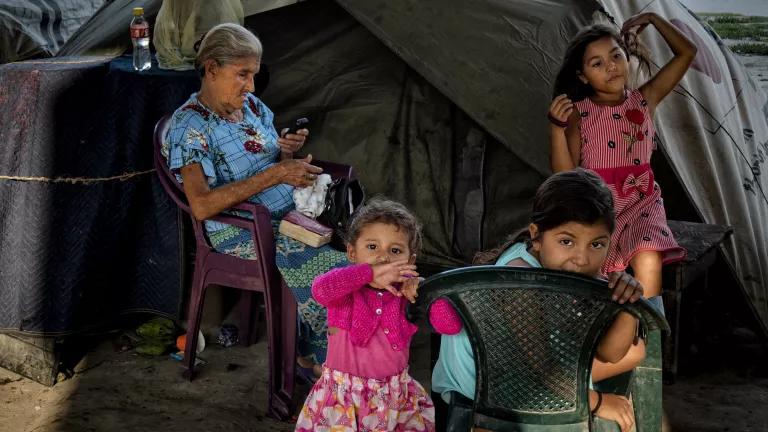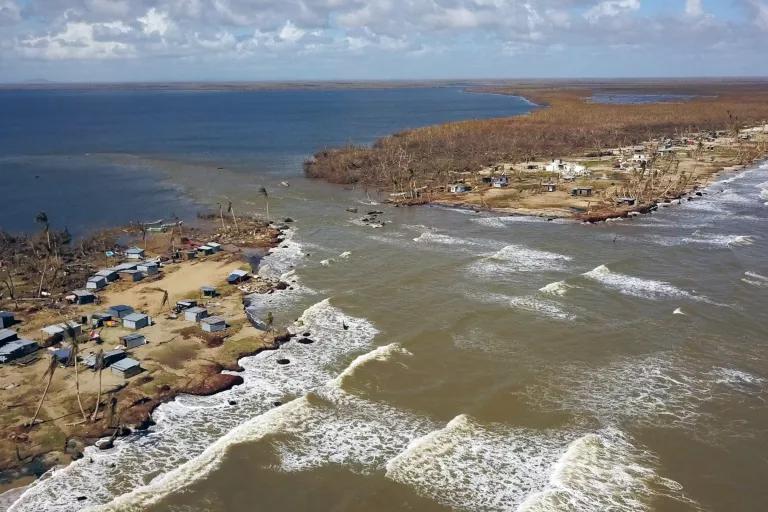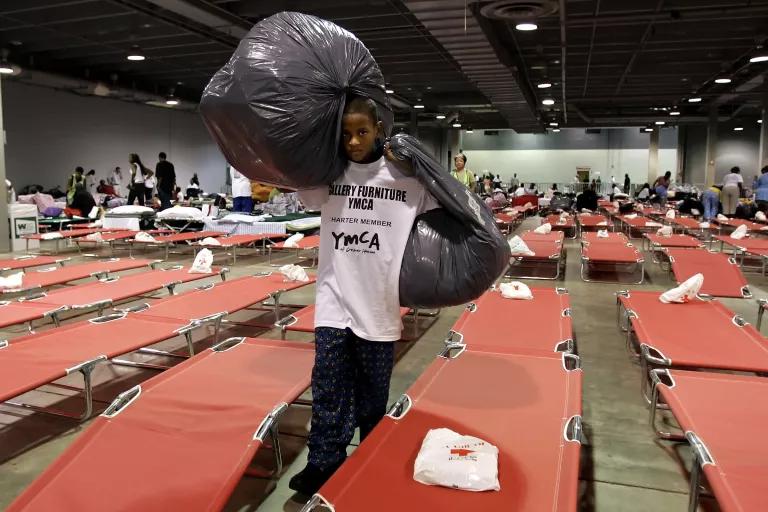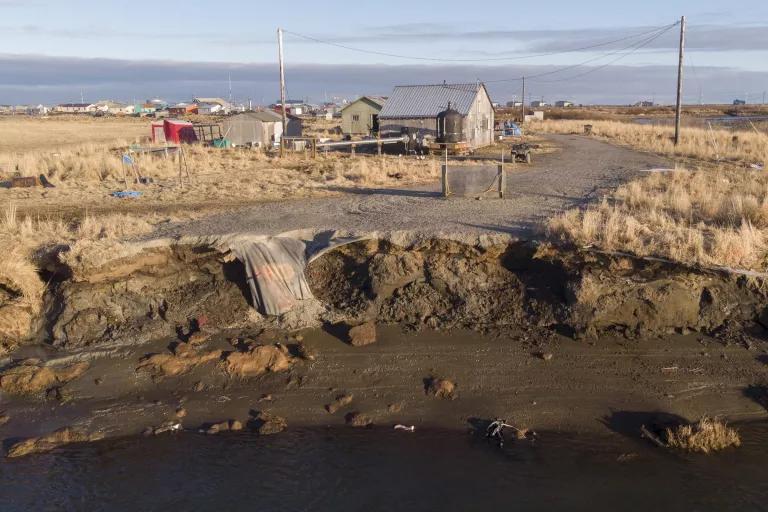Climate Migration and Equity
Inequality influences who can stay in climate-vulnerable locales and who can leave and thrive elsewhere. The world needs a plan that supports those climate refugees who can’t do either.

A family shelters under a highway after floods destroyed their home in Honduras.
Juan Carlos/Hans Lucas/Redux
Wildfires. Floods. Hurricanes. For years, the consequences of carbon-fueled climate change have been upending lives and causing people to migrate. And those are just the sudden climate catastrophes.
The slower-moving disasters—sea levels that creep farther inland, temperatures that diminish crop yields, storms that dump more and more rain, and rainstorms that fail to appear at all—are even more likely to cause people to leave home and never come back.
These insidious climate impacts have already begun. Indigenous communities in Alaska have been watching their villages wash away for decades as permafrost melts at an alarming rate. Tribal residents along the coast of Louisiana lose a football field’s worth of land to the Gulf of Mexico every 90 minutes, due to rising sea levels and land subsidence, both of which are precipitated by the fossil fuel industry. In Bangladesh, rural residents are fleeing to the low-lying nation’s cities to escape frequent flooding and loss of farmland. Nations in the Pacific Ocean, like Kiribati, are calling for action as their islands slowly slip beneath the waves. The list goes on and on.
What Is Climate Migration?
In 2016, President Obama formally observed the relationship between climate change, migration, and sociopolitical instability in the “Climate Change and National Security” memorandum. The memo described the many impacts of climate change—from rising sea levels to food shortages to extended drought—that could “lead to population migration within and across international borders, spur crises, and amplify or accelerate conflict in countries or regions already facing instability and fragility.”
Two years later, the World Bank estimated that climate change would displace more than 140 million people within their home countries in sub-Saharan Africa, South Asia, and Latin America by 2050.
“Climate displacement is movement, in part due to climate-related disasters, both sudden and slow-onset disasters, that are either temporary or permanent, within countries or across borders,” explains Ama Francis, climate displacement project strategist at the International Refugee Assistance Project (IRAP). Through their work at this New York City–based organization that fights for the legal rights of refugees, Francis is focused on addressing the structural inequalities—social, economic, or political—that shape a person’s decision or ability to move elsewhere. Those with fewer financial resources or those who are caretakers for others, for example, can’t as easily pick up and start somewhere new.
Climate change refugees
Across the world, the climate crisis disproportionately impacts Black, Indigenous, and other people of color, especially women. In fact, the United Nations estimates that women make up 80 percent of climate refugees. Not only are women, who are often caretakers, more likely than men to experience poverty, which impedes their recoveries from climate disasters, but the risks of gender-based violence against women and girls rise in areas disrupted by climate change.
Of course, the disproportionate impacts of climate change don’t end at the community level. Wealthy countries caused the climate crisis that is now making low-income countries less habitable. According to a report from Oxfam and the Stockholm Environment Institute, people with the top 1 percent highest incomes globally, a group of about 63 million, emitted twice the amount of carbon emissions between 1990 and 2015 as those with incomes in the bottom 50 percent, the equivalent of 3.1 billion people.

In the town of Haulover, Nicaragua, families are torn between rebuilding in the same vulnerable area or relocating inland to allow greater protection from future storms.
Cesar Nunez/The New York Times/Redux
Needed: A global solution
After years of failing to acknowledge the links between migration and climate change, world leaders finally connected the dots in 2015 and decided to develop an integrated approach to solving both problems. They established the Task Force on Displacement at the 21st Conference of the Parties (COP21) in Paris, which paved the way for the creation three years later of the Global Compact on Safe, Orderly, and Regular Migration and the Global Compact on Refugees. The groups have started important conversations but have yet to take concrete next steps.
A big issue standing in the way of progress is a lack of funding for climate adaptation relative to mitigation, says Francis, a native of the Caribbean island of Dominica, which was devastated in 2017 by Hurricanes Irma and Maria. “What's really central for climate displacement right now is making sure that there are enough resources flowing toward adaptation, so that people not only have the option to move but also have an option to stay at home if that's what they want.”
This imbalance is exactly what Salote Soqo, the director of advocacy for global displacement at the Unitarian Universalist Service Committee (UUSC), is working to fix. By financially supporting frontline community groups in the Pacific that have been marginalized from mainstream funding sources, Soqo and the UUSC aim to help those who are either relocating now or likely will be in the near future. As an Indigenous woman of Fiji, where more than 40 communities are currently identified for relocation, Soqo laments the fact that global climate efforts haven’t focused on plans and preparations for such moves.
A video from Fiji’s National Disaster Management Office (NDMO) featuring residents of the village of Tukuraki three years after their relocation due to landslides.
Across the globe, the numbers of people being displaced keep climbing. According to a report by the International Federation of Red Cross and Red Crescent Societies, 98 percent of disasters were related to “weather and climate” and internally displaced 30.7 million people in 2020. That year, Central America was particularly hard hit when two back-to-back Category 4 hurricanes, Eta and Iota, swept through, displacing at least 1.5 million people in Guatemala, Honduras, and Nicaragua.
Soqo says, “We need to get more serious about human mobility in those spaces.”
Countries most affected by climate change
As the Intergovernmental Panel on Climate Change’s Sixth Assessment report makes clear, while the climate crisis is affecting everyone on the planet, it does not affect everyone equally. For example, countries in South Asia, tropical sub-Saharan Africa, and parts of Central and South America will feel much of the impact of deadly heat stress, but Europe and North America won't be spared.
And the IPCC authors write that flooding events due to rising sea levels could lead to “very high losses in East Asian cities." They also predict that "by midcentury, more than a billion people living in low-lying coastal cities and settlements globally are projected to be at risk from coastal-specific climate hazards."

John Taylor carries his family's belongings, after moving into the Reliant Arena in Houston in the aftermath of Hurricane Katrina in 2005.
AP Photo/David J. Phillip
Step it up, United States
Given the scale of these threats, the Biden administration’s publication of a 2021 report on the impact of climate on migration (released prior to the COP26 meeting in Glasgow, Scotland) came not a moment too soon. While it was the first U.S. government report of its kind, Francis says it was significant for several other reasons as well.
First, it recognizes that climate displacement is an issue happening right now—not in some abstract future world. Second, the report shows that the United States wants to figure out how to use new and existing legal pathways for climate-displaced people, such as through Temporary Protected Status and by expanding the list of eligible origin countries. And, lastly, it led the administration to set up a task force on the matter.
“This report really says to climate-displaced people, ‘we see you, you matter, there are things that the U.S. government can do to protect you,’” Francis says.
But while establishing the task force was a laudable step, the administration could do more to put forth solutions. After all, millions of people are getting caught in the climate crosshairs, and they have no time to wait for action.
The report also omits displacement concerns within U.S. borders. In the two weeks following Hurricane Katrina in 2005, the country saw the largest and fastest dislocation in the United States since at least the mid-1800s, with more than 1 million people fleeing the Gulf Coast region. And the recovery and return process was far more lengthy for Black New Orleanians than it was for white residents.
Indigenous groups all across the country have increasingly grappled with similar injustices—facing more extreme heat and less precipitation on their lands, generally, as a recent study found—and they’ve been left to navigate relocation processes without much guidance or financial support. Robin Bronen of the Alaska Institute for Justice, who has been advocating for displaced Alaska Natives for decades, is frustrated by the inaction. “I think this is preventable, and we are not preventing this crisis,” she says. “We have zero capacity right now in the United States to deal with it.”
Finally, the report, which was led by the National Security Council, should have been more clear that climate change is the national security threat here—not the migrants themselves.
“There's a way in which climate displacement has been used to fuel fear of immigration and immigrants,” Francis explains. “The issue has definitely been co-opted by xenophobic actors who push this narrative that there are millions of climate-displaced people who are going to arrive in the United States, and therefore the U.S. needs to harden its borders.” Meanwhile, some elected U.S. officials have been finding new ways to block the resettlement of refugees and asylum seekers. IRAP has other ideas.

Erosion caused by melting permafrost and the disappearance of sea ice threatens the Yup'ik village of Quinhagak in Alaska, where local leaders have been considering moving the community to safer ground.
Mark Ralston/AFP/Getty
A path forward
In August 2021, IRAP released its own report that outlines policies the United States could adopt to address climate migration. Among other things, the organization calls for the U.S. Department of Justice to issue clear guidelines recognizing that environmental harm frequently combines with other drivers of displacement that qualify someone for refugee status. One important and immediate next step, Francis says, would be to train immigration officers and judges to recognize that some people displaced by climate change are eligible for refugee status under current U.S. law. “And that's something that the government can do without needing any new legal authority or any authorization from Congress.”
The report, endorsed by NRDC and other organizations, came on the heels of a UUSC policy brief that made recommendations, such as granting funds directly to frontline communities and changing the way the Federal Emergency Management Agency distributes aid in the wake of a disaster. In her own recommendations, Bronen suggests creating a national governance framework for climate relocation, which would include tribal governments and community-based organizations in decision-making processes. The solutions to such a wide-ranging and urgent issue will most certainly be a team effort.
“What's desperately needed is for all of us to pay attention to the places where we live and how they're changing, so that we can help inform the responses of how we're going to adapt,” she says.
“We tend to think this is going to happen to somebody else, and not us, because either we have enough money or we live in a place we think is going to be safe. And based on my experience of living in Alaska, I don't think anywhere is safe.”
This NRDC.org story is available for online republication by news media outlets or nonprofits under these conditions: The writer(s) must be credited with a byline; you must note prominently that the story was originally published by NRDC.org and link to the original; the story cannot be edited (beyond simple things such as grammar); you can’t resell the story in any form or grant republishing rights to other outlets; you can’t republish our material wholesale or automatically—you need to select stories individually; you can’t republish the photos or graphics on our site without specific permission; you should drop us a note to let us know when you’ve used one of our stories.


Climate Tipping Points Are Closer Than Once Thought
What Are the Effects of Climate Change?
What Is Climate Feminism?